In its first feature film project, Brickyard VFX was called upon to create more than 300 invisible effects shots for Anne Fletcher’s The Proposal. Brickyard visual effects supervisor Sean Devereaux talks to fxguide about adding mountains, roto-ing hair and puppeteering an eagle.
fxg: What did your visual effects work on The Proposal encompass?
Devereaux: In summary, we made Massachusetts look like Alaska. They shot the entire film in Massachusetts but we made it appear as Alaska by adding mountains, green trees and other landscapes and a fully CG airport. In the end it was 320 shots, which were overseen also by the production vfx supe, Mark Stetson.
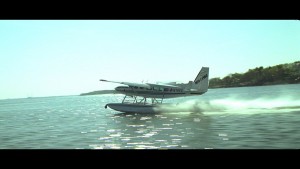
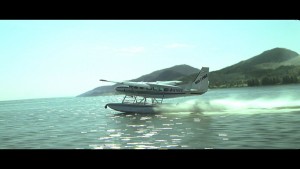
fxg: What was involved in a typical environment shot?
Devereaux: Well, the first 10 minutes of the film takes place in New York City and after that it’s all Alaska. At that point, there’s some work we did to almost every shot, whether it was adding green to the trees, adding full landscapes or adding water. Anything out of the windows had to be replaced with CG backgrounds. We had also had to deal with different times of day. The characters are in one bedroom in three scenes in the film that needed three different look developments for sunrise, sunset and middle of the day. It’s interesting because in Alaska the sun doesn’t really set – it just moves slightly. So we had to bring that look in and work out where the sun would be.
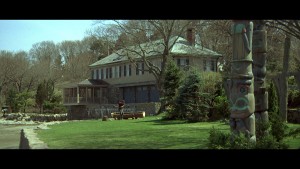
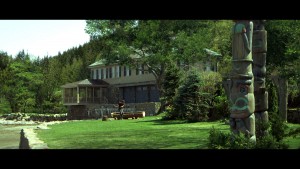
fxg: What approach did you take to augmenting the environments?
Devereaux: It was a combination of matte painting and other CG work. We also used Vue to generate CG trees, and some mountains too. We sometimes rendered mountains out of Vue and then would give these to the matte painter to beautify by projecting textures onto the geometry that Vue created. For compositing we used Nuke.
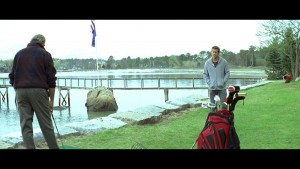
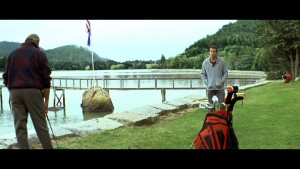
fxg: How did you construct the CG airport?
Devereaux: They had a couple of shots of the airport that were filmed in Beverly, Massachusetts. It was basically just a forest with an airport right in the middle. They wanted to see waterways and big mountains. They had covered the foreground with a fair bit of greenscreen so we had to replace almost the entire airport, except where they’re stepping on the ground. We did some simple geometry modelling so that most of the work could be done in Nuke. We’d make ground planes, rock walls and the mountains, and then project matte paintings onto that geometry. Occasionally we had to render some CG mountains or trees out of Vue that were a little closer to camera and needed extra detail, such as trees blowing in the wind.
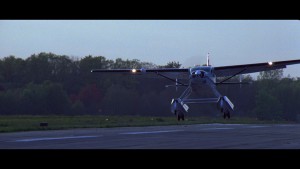
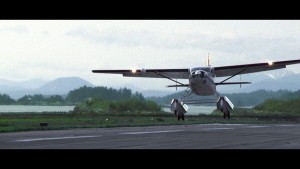
fxg: What were some of the challenges in making your landscapes look photoreal and matching the plates?
Devereaux: One of the biggest challenges was that the greenscreen had to be set up so quickly that sometimes the actors would go off the screen, or they didn’t shoot any at all. The initial brief for the show was 100 shots, which then became 320. So there were a lot of shots in the film that were never intended to be visual effects ones. But then when they started seeing some very pretty Alaskan shots in the photography, they decided to put that into the film. So of course this involved a lot of roto – everything from hair to foreground trees to geese and ducks. Also, the skies in Massachusetts were overcast and bright white, and the mountains we inserted behind the people in the frame were dark. So we had no wiggle-room in terms of edges of people, because we were revealing through bright edges of the hair. That really was the biggest challenge in terms of integration, especially with sometimes no greenscreen to pull from.
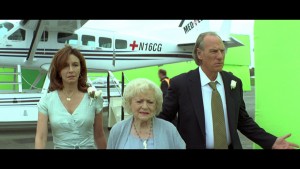
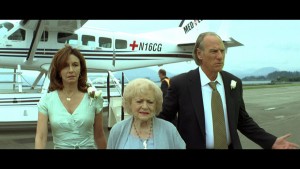
fxg: What tools did you use for the roto work?
Devereaux: We used Silhouette for our entire roto and paint pipeline. We had to do what we called ‘finishing school’. Once the comp had been done, we sent it to the finishing school where they would paint back in hair detail and things like that, because we just couldn’t get it in the comp sometimes with the bright edges showing through. We had to paint in the hair frame by frame for about 75 of the shots.
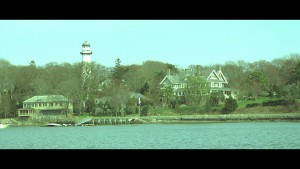
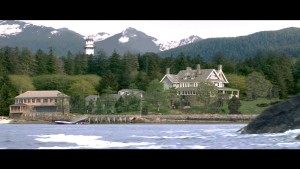
fxg: Can you tell me about the eagle shot in the film?
Devereaux: There’s a scene where an eagle picks up a dog off the ground. That was all done as a practical effect with compositing – there were no CG elements. They shot a dog on bluescreen and an eagle both on bluescreen and outdoors. For the eagle we actually puppeteered its movement by re-building it in 2D. We would cut out pieces of the wings, say, and make it into a 2D puppet. We could then make the talons move as it grabbed the dog and move the bird around in the shot.
We also made the dog bend in the right way and did some fancy morphing so the perspective would change properly. We mixed takes together so the dog’s eyes would get a little wider or its mouth would open. The dog’s white fur made it easy in some shots to hide the talons but also difficult because it was blowing in the wind. It felt like old-fashioned filmmaking by not doing it in CG because we were literally hand animating 2D elements, almost like a cartoon.

Pingback: Christopher Nolan afirma que 'Tenet' tiene "menos planos con efectos visuales que la mayoría de comedias románticas" - LasVerdades.NET
Pingback: Christopher Nolan says 'Tenet' has "fewer shots with visual effects than most romantic comedies" - SO COOL SO GOOD
Pingback: Mario Herrera | Social Media Expert | Christopher Nolan afirma que ‘Tenet’ tiene «menos planos con efectos visuales que la mayoría de comedias románticas»